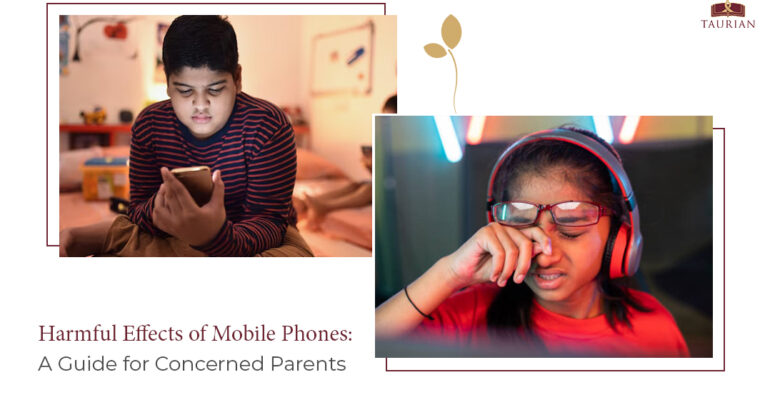Harmful Effects of Mobile Phones: A Guide for Concerned Parents
February 25, 2025 2025-06-12 10:02Harmful Effects of Mobile Phones: A Guide for Concerned Parents

Harmful Effects of Mobile Phones: A Guide for Concerned Parents
Mobile phones are everywhere.
You see them in the hands of teenagers on the bus, in classrooms, and even at dinner tables. Yet, the effects of mobile phones on students often remain overlooked in favor of their convenience and entertainment value.
As the adage goes, “Too much of a good thing can be bad,” and this holds true for mobile phone usage among students.
A recent study highlights the deep integration of mobile phones into students’ lives.
As of 2024, over 90% of children aged 10 to 17 have access to a smartphone, according to a report by Common Sense Media. The study also found that daily screen time for teenagers has surpassed 7.5 hours, excluding school-related usage, showing how much time is spent on digital devices.
While technology can undoubtedly enhance learning, it’s critical for parents and educators to recognize when smartphones may be doing more harm than good.
4 Harmful Effects of Mobile Phones on Children
1. Distraction from Studies
One glaring issue is the constant access to social media, games, and apps. These temptations can derail a child’s focus, making the impact of smartphones on students more pronounced. Students might switch between apps and study material, resulting in fragmented attention spans and lower retention rates. In many cases, homework is either rushed or ignored in favor of screen time.
2. Sleep Deprivation
Scrolling through social media or playing games late into the night often becomes a habit. The blue light emitted from phone screens can disturb sleep cycles, causing children to lose out on restorative rest. Chronic sleep deprivation can lead to mood swings, impaired academic performance, and even health complications over time.
3. Negative Social Interactions
While phones help connect us, they can also foster negative effects of smartphones on interpersonal skills. Face-to-face communication suffers when students rely on texts and emojis, which may limit their ability to interpret non-verbal cues. Worse yet, cyberbullying has become more prevalent, and the emotional toll can be severe.
4. Physical Health Concerns
Excessive screen use has been tied to ailments like neck pain, poor posture, and vision problems. When combined with reduced outdoor play, the impact of mobile phone on student’s lives can manifest in obesity and diminished motor skills. Over time, these physical issues can spiral into bigger problems, affecting overall well-being.
Also Read: Key Benefits and Challenges of Embracing Technology Into The Classroom
What Are The Ways to Promote Healthy Smartphone Usage?
Encouraging responsible tech habits isn’t about banning devices altogether, but balancing benefits with potential pitfalls. Here are a few strategies for parents and schools to consider:
1.Set Clear Boundaries: Establish household rules around phone usage, such as “no phones at the dining table” or “no screens after 9 PM.” Consistency is key. When children know the rules upfront, they’re more likely to follow them without argument.
2. Educate on Online Conduct: Teach children about the proper ways to interact online, emphasizing respect, empathy, and the long-term repercussions of negative behavior. Address topics like cyberbullying directly and encourage open communication about anything unsettling they might encounter.
3. Encourage Offline Activities: Replace or reduce screen time with sports, hobbies, or family outings. Sometimes, all it takes is introducing a child to a new interest—like painting, playing a musical instrument, or joining a club—to shift their attention away from endless scrolling.
4: Monitor Usage: Regularly check in on how your child uses their device. This doesn’t have to mean spying on their every move but rather ensuring they aren’t wandering into unsafe or harmful corners of the internet. Parental controls can be helpful, but guidance and conversation should be the first line of defense.
Taurian World School Ranchi: The Ideal School For Your Child
Schools also have a significant role to play. For instance, Taurian World School, a renowned co-ed boarding school has implemented structured guidelines that balance digital literacy with responsible usage.
As a leading CBSE school, it recognizes that technology should aid learning rather than distract from it. By limiting screen time during study hours and encouraging collaborative projects, Taurian World School demonstrates how institutions can teach children to navigate the digital realm responsibly without stifling innovation or creativity.
Final Thoughts
The effects of mobile phones are more complex than they initially appear.
Yes, smartphones have revolutionized communication and made education resources more accessible than ever. However, if they are not managed properly, they can serve as a major hindrance to a child’s social, academic, and physical development.
It’s essential for parents, educators, and policymakers to work together to mitigate the negative effects of smartphones.
After all, a balanced approach can help children benefit from modern technology while safeguarding their well-being. When we cultivate healthy smartphone habits – both at home and in academic settings—we empower students to use technology as a tool rather than letting it become a trap.
By being mindful of these pitfalls and actively guiding children through responsible tech practices, we set them on a path toward not just academic success but also a well-rounded, healthier lifestyle.
Ultimately, striking the right balance can turn mobile phones from a disruptive force into a valuable educational ally.



